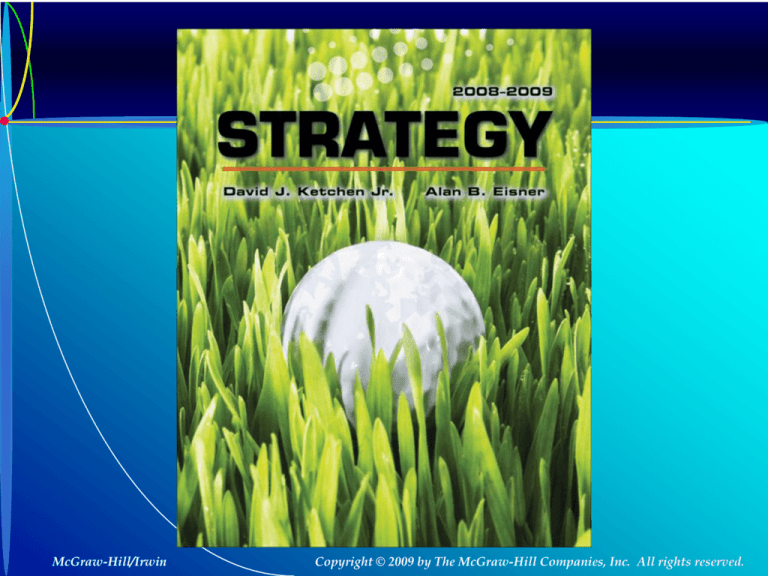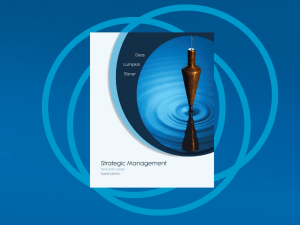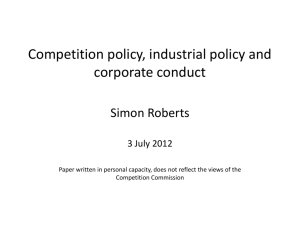
McGraw-Hill/Irwin
Copyright © 2009 by The McGraw-Hill Companies, Inc. All rights reserved.
Chapter 2
The Context of Strategic
Management
Learning Objectives
After reading this chapter, you should have a good
understanding of:
The effects of globalization and business ethics on today’s
organizations and on the nature of competition.
The sources of national advantage, that is, why an industry
in a given country is more (or less) successful than the
same industry in another country.
The potential benefits and risks of international expansion.
The vital role of corporate governance and stakeholder
management as well as how “symbiosis” can be achieved
among an organization’s stakeholders.
The importance of social responsibility, including
environmental sustainability
2-3
The Global Economy: A Brief Overview
Opportunities and risks when firms diversify
abroad
Trade across nations will exceed trade within
nations
Rise of market capitalism around the world
Transfer of money from rich to poor countries
Equity
Bond Investments
Commercial loans
2-4
The Global Economy: A Brief Overview
Why do some countries enjoy the fruits of
global capitalism while others are mired in
poverty?
Need of governments to have track records of
business friendly policies
Invest in modern technology
Nurture local suppliers
Must manage broader economic factors
Interest rates, inflation, unemployment
2-5
Factors Affecting
a Nation’s Competitiveness
Factor conditions
Nation’s position in factors of production
Skilled labor
Infrastructure – Transportation, communication,
Utilities, Educational
Demand conditions
Nature of home-market demand
Industry’s product
Industry’s service
2-6
Factors Affecting
a Nation’s Competitiveness
Related and supporting industries
Presence or absence in the nation of internationally
competitive
Supplier industries
Other related industries
Firm strategy, structure, and rivalry
Conditions in the nation governing how companies are
Created, Organized, and Managed
Nature of domestic rivalry
2-7
Factor Conditions
To achieve competitive advantage, factors of
production must be created
Industry specific
Firm specific
Pool of resources at a firm’s or country’s disposal is
less important than the speed and efficiency with
which the resources are deployed
2-8
Demand Conditions
Demands that consumers place on an industry
for goods and services
Demanding consumers push firms to move ahead of
companies from other nations
Demanding consumers drive firms in a country to:
Meet high standards
Upgrade existing products and services
Create innovative products and services
2-9
Example
The demand for gasoline in the United States
has not fallen despite recent surges in gasoline
prices.
An increased supply has eased the price of
gasoline for consumers recently.
There are still several risks that could affect the
demand conditions for gasoline
The high price of Ethanol
Volatility in the oil market
Source: Business Week, June 5, 2006
2-10
Related and Supporting Industries
Enable firms to manage inputs more effectively
Strong supplier base adds efficiency to downstream
activities
Competitive supplier base lets a firm obtain inputs
using cost-effective, timely methods
Allow joint efforts among firms
Create the probability that new entrants will
enter the market
2-11
Firm Strategy, Structure and Rivalry
Rivalry is intense in nations with conditions of
Strong consumer demand
Strong supplier bases
High new entrant potential from related industries
Competitive rivalry increases the efficiency with
which firms develop, market, and distribute
products and services within the home country
2-12
Firm Strategy, Structure and Rivalry
Competitive rivalry increases the efficiency
with which firms
Develop within the home country
Market within the home country
Distribute products and services within the home
country
2-13
Firm Strategy, Structure and Rivalry
Domestic rivalry provides a strong impetus for
firms to
Innovate
Find new sources of competitive advantage
Domestic rivalry forces firms to look beyond
national borders for new markets
2-14
Porter’s Diamond of National Advantage:
As Applied to India
A Company’s Motivation for International
Expansion
Increase the size of potential markets
World population exceeds 6.5 billion
U.S. represents 5% of world population
China and India increased middle class
Attain economies of scale
Larger revenue and asset base
Advantage is spreading fixed costs over larger volume
of production
2-16
A Company’s Motivation for International
Expansion
2-17
A Company’s Motivation for International
Expansion
Reducing the costs of R&D as well as operating
costs
Attainment of greater purchasing power by pooling
purchases
Extend the life cycle of a product
Four stages: introduction, growth, maturity, decline
Optimize the physical location for every activity in
its value chain
Performance enhancement
Cost reduction
Risk reduction
2-18
Potential Risks of
International Expansion
Political and economic risk
Social unrest
Military turmoil
Demonstrations
Violent conflicts and terrorism
Laws and their enforcement
2-19
Example - 2006 CPI
Corruption Perceptions Index
Reveals the most corrupt countries in the world
The five most corrupt countries in 2006 were:
1.
2.
3.
4.
5.
Haiti (CPI Score: 1.8)
Myanmar (CPI Score: 1.9)
Iraq (CPI Score: 1.9)
Guinea (CPI Score: 1.9)
Sudan (CPI Score: 2.0)
Source: Transparency International, 2006, www.transparency.org
2-20
Risk Rankings
2-21
Potential Risks of
International Expansion
Currency risks
Must constantly monitor exchange rate between its
own currency and host country
Currency exchange fluctuations
Appreciation of the U.S. dollar
Exchange rates can significantly affect production
costs or net profit
2-22
Potential Risks of
International Expansion
Management risks
Culture
Customs
Language
Symbols
Income levels
Customer preferences
Distribution system
Recent trend -- Dispersion of value chains of
multinational corporations across different
countries
2-23
Question
When a firm decides to shift an activity that they were
previously performing in a domestic location to a
foreign location it is called:
a)
b)
c)
d)
outsourcing
contracting
offshoring
exporting
2-24
Outsourcing and Offshoring
Outsourcing occurs when a firm decides to utilize
other firms to perform value-creating activities
that were previously performed in-house.
Offshoring takes place when a firm decides to
shift an activity that they were previously
performing in a domestic location to a foreign
location.
2-25
Outsourcing and Offshoring
Until 1960s, entire value chain was in one
location
Production took place near customers to limit
transportation costs
Rapid decline in transportation costs has enabled
firms to disperse over multiple locations
Service industry followed manufacturing
Outsourcing low-level programming and data entry
work
2-26
Corporate Governance and Stakeholder
Management
Corporate governance: the relationship
among various participants in determining the
direction and performance of a corporation
Shareholders
Management (led by the CEO)
Board of Directors
2-27
Question
Briefly describe the role of board of directors in
corporate governance.
2-28
Corporate Governance and Stakeholder
Management
Board of Directors
Elected representatives of the owners
Ensure interests and motives of management are
aligned with those of the owners
Effective and engaged Board of Directors
Shareholder activism
Proper managerial rewards and incentives
2-29
Corporate Governance and Stakeholder
Management
2-30
Example: New Rules for Directors
In light of numerous corporate scandals, the role
and rules for board of directors are being
redefined. Few areas of focus :
Numbers Knowledge
Strategy Focus
Time & Understanding
Watchdog
Source: Tipsheet, Business Week, January 22, 2007
2-31
Corporate Governance and Stakeholder
Management
Concerns about corporate governance led to the
Sarbanes-Oxley Act in 2002
U.S. Corporations must abide by:
CEOs and CFOs must fully reveal off-balance-sheet
finances and vouch for the accuracy of the information
Executives must promptly reveal the sale of shares in
firms they manage and are not allowed to sell shares
when other employees cannot
Corporate lawyers must report to senior managers any
violations of securities laws within the organization
2-32
Governance Mechanisms: Aligning the
Interests of Owners and Managers
Two primary means of monitoring behavior of
managers:
A committed and involved board of directors that acts in
best interests of shareholders
Shareholder activism: owners view themselves as
shareowners
Become actively engaged in governance of corporation
Managerial incentives called “contract-based outcomes”
Goal is to craft incentive packages to align interests of
management with those of stockholders
2-33
Governance Mechanisms: Aligning the
Interests of Owners and Managers
2-34
Governance Mechanisms: Aligning the
Interests of Owners and Managers
Business Roundtable describes BoD duties as:
Select, regularly evaluate, and if necessary, replace chief
executive officer. Determine management compensation.
Review succession planning
Review and, where appropriate, approve the financial
objectives, major strategies, and plans of the corporation
Provide advice and counsel to top management
Select and recommend to shareholders for election an
appropriate slate of candidates for BoD; evaluate board
processes and performance
Review the adequacy of the systems to comply with all
applicable laws/ regulations
2-35
Stakeholder Management
Two views of stakeholder management
Zero sum
Stakeholders compete for attention and resources of
the organization
Gain of one is a loss to the other
Symbiosis
Stakeholders are dependent upon each other
Mutual benefits
2-36
Key Stakeholders
2-37
Question
The expectation that businesses or individuals
will strive to improve the overall welfare of society
is called:
a)
b)
c)
d)
social responsibility
social ethics
morals
economic distribution
2-38
Social Responsibility
Social responsibility: the expectation that
businesses or individuals will strive to improve
the overall welfare of society
Managers must take active steps to make society
better
Socially responsible behavior changes over time
Triple bottom line
2-39
Example: Social Responsibility
Starbucks Coffee Company
Corporate social responsibility is embedded
throughout the organization.
The following are some of the commitments
they have made to be socially responsible:
Commitment to origins
Helping protect the environment
Starbucks in your community
Commitment to partners
Source: www.starbucks.com
2-40




![Lecture 2a How to Th.. - of [www.mdavis.cox.smu.edu]](http://s3.studylib.net/store/data/008571683_1-b9817424524385f28bc5c351abe2212a-300x300.png)




